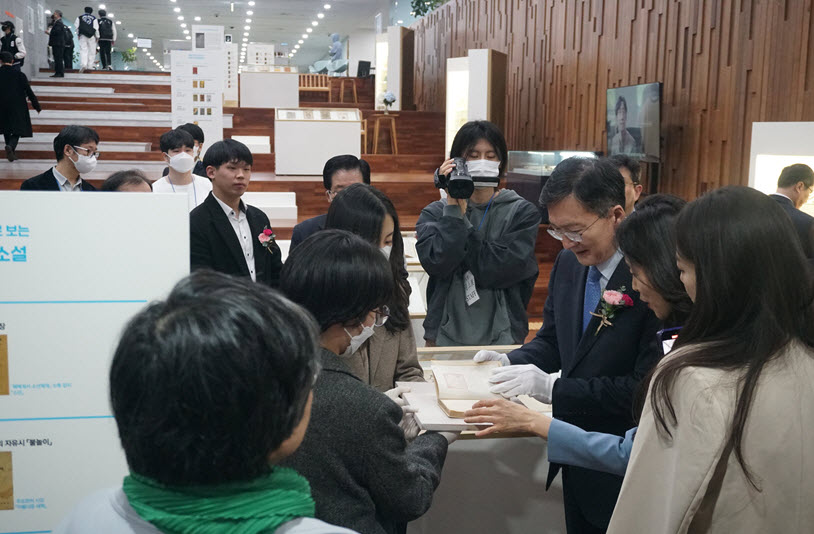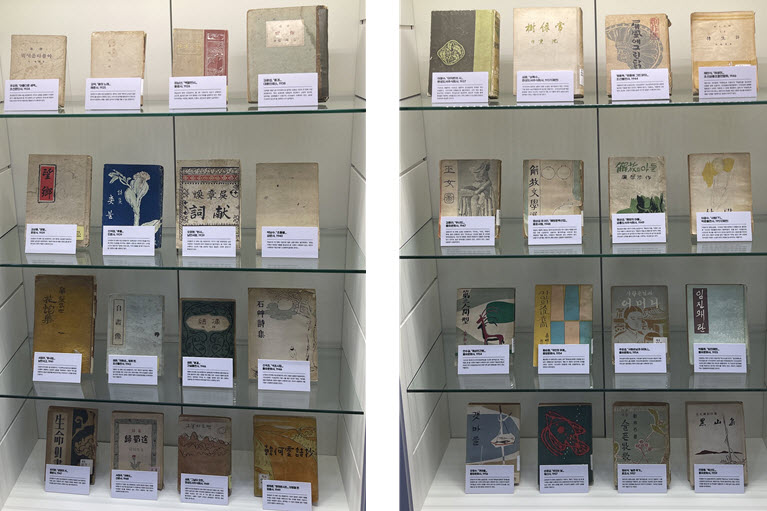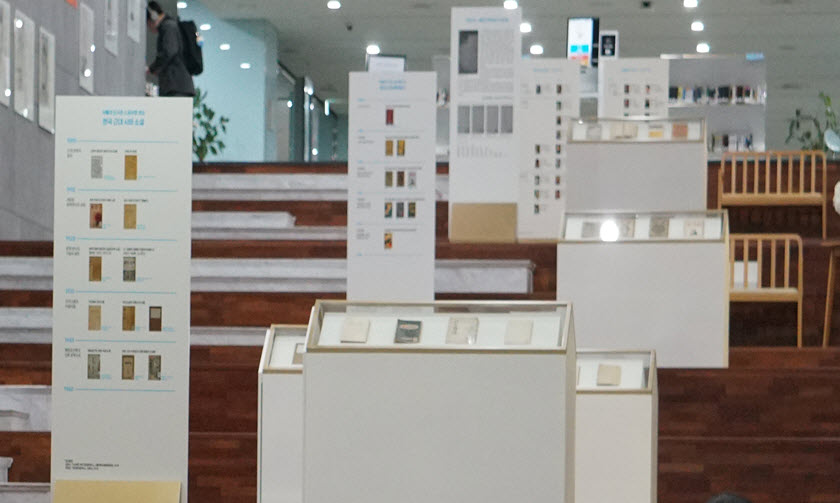The Central Library (Director Chang, Dukjin) has opened a special exhibition that connects literature and the students of Seoul National University. Titled "Poems and Novels We Love, The Literature of SNU," the exhibition showcases over 100 Korean modern literary works from SNU Central Library collection along with major works of authors who graduated from Seoul National University. The exhibition will be held from March 14 (Tue) to May 19 (Fri) at Kwanjeong-maru, located on the first floor of the Kwanjeong Library. Director Chang stated, "We are organizing this exhibition at the Central Library because it holds memories of Seoul National University members, to revive the memories and traditions of Seoul National University and to connect to the future." He also emphasized the meaning of "Visang (飛上)" stating, “I hope this exhibition will serve as an opportunity for the freshmen this year to experience the heritage of their seniors and soar to greater, higher places.”

Freshmen Exhibition “Visang - Poems and Novels We Love, The Literature of SNU" will be held from March 14 (Tue) to May 19 (Fri) at Kwanjeong-maru, 1st floor of Kwanjeong Library.

Honglim Ryu, the president of Seoul National University, is looking at the materials of the ancient documents in the exhibition.
Weaving Together Modern and Present Korean Literature History
This special exhibition, first to be held in 27 years since the precious book exhibition in 1996, allows visitors to vividly enjoy the modern literary materials that the Central Library has collected over a long period of time. The literary materials used in the exhibition were obtained from the collections established in the Central Library, such as "Garam Collection," "Baeksa Collection," and "Ilsa Collection." The names of each collection originate from the pen names of Garam Lee Byeong-gi, Baeksa Jeon Gwang-yong, and Ilsa Bang Jong-hyeon, prominent scholars who established the framework of Korean modern literary research. In particular, the excellence of the modern literary materials Seoul National University preserves can be experienced through the first edition of “Cheongchun” (1914), the first edition of “Heaven and Wind and Starts and Poems” (1948), “Heuksando” (1959), and “Kapitan Ri” (1975) collected by Garam Lee Byeong-gi, who made significant contributions to the study and education of the Korean traditional verse sijo and the first edition of “Munyeodo” (1947) and the first edition of “Sandohwa” (1955) collected by Baeksa Jeon Gwang-yong, who authored representative Korean novels.
The exhibition is divided into three main categories: poetry collections, fiction collections, and literary magazines, allowing visitors to appreciate a wide range of modern literary works in accordance to their chronological flow. After visitors go through prominent works such as "One Hundred and Eight Torments" (1926), a poetry collection by Choi Nam-seon, a famous poet and editor known for his new-style poetry; and "Hwasajip" (1941), a lyric poetry collection by Seo Jeong-ju known for his distinctive sensual vitality, visitors are greeted with the displays of the first and revised edition of "Jeong Ji-yong Collection" (1935) which was written and transmitted by Jeong Ji-yong himself to his teacher Garam Lee Byeong-gi in commemoration of his first publication.
Fiction collections from the era of literati activities which we could only encounter through textbooks can also be viewed in their actual physical form. Novel "Sangnoksu" (1937) written by Shim Hun, the master of Korean rural novels of the 1930s; "The Third Human" (1954), a novel collection by An Su-gil seeking the meaning of life after the Korean War; and "Liberation Literature Collection (Haebangmunhakseonjip)" (1948), a collection of short stories of nine contemporary writers such as Yeom Sang-seop, Kim Dong-ri, and Gye Yong-muk and of which the cover was painted by the artist Kim Hwan-gi, illustrate to us the diverse stories of life. Alongside these, various inaugural issues of modern literary magazines decorated in different colors capture the attention of visitors. "Sonyeon" (1908-1911) and "Cheongchun" (1914-1918), the first children's magazines published by Choi Nam-seon, announced the emergence of modern comprehensive magazines. "Baekjo" (1922-1923), published by literary youths such as Hong Sayong, Park Jong-hwa, and Na Do-hyang and Korea’s first newspaper journal, Dong-A Daily News’ "Shindonga" (1931), cannot be left out from the genealogy of modern literary magazines. In particular, the "Munjang" (1939-1941) collection, which discovered literary giants such as Park Mok-wol and Jo Ji-hoon, fills one entire wall and demonstrates the passage of time.

The exhibition is divided into three main categories: poetry collections, fiction collections, and literary magazines, allowing visitors to appreciate a wide range of modern literary works according to their chronological flow.
Literature of SNU Students, Connecting the Past, Today, and the Future.
This exhibition also holds significance in that it brings together the members of Seoul National University through literature. The exhibition displays the plots and messages of 34 works left behind by 27 writers who are Seoul National University graduates. The poem collection "Redundancies of Chaos" (1958) by Jeong Han-mo (Class of '47, Korean Language and Literature) which depicts the horrors of the Korean War, and "Snow over the Three Nam-Provinces" (1975) by Hwang Dong-gyu (Class of '57, English Language and Literature) that expresses the resistance of people under the military regime of the 1970s allow us to feel the traces of an era we did not experience.
From Kim Ji-ha’s (Class of '59, Aesthetics) poetry collection "Ojeok" (1985) metaphorically describing those who engaged in corruption and bribery of the 1980s as the “Five Eulsa Traitors,” to Shim Bo-seon’s (Class of '88, Sociology) poetry collection, “Person Not Existing Before One’s Eyes” (2012), consoling the social wounds after the 2009 Yongsan tragedy, the concise language of the poets awakens the existences that we should once again commemorate in our minds. Alongside the exhibited work, sits a commentary with the interpretation of the works. According to the commentary written by Professor Shin Hyeong-cheol (Department of English Language and Literature), history has wounded the poets, but the poets gave accurate expressions to their wounds, making them readable beyond time. The exhibition continues with the novels of the world we live in. Choi Il-nam’s (Class of '52, Korean Language and Literature) “Flowing Drum”(1986), “Bare Tree” (1970), and “Thirsty Season” (1972) by by Park Wan-suh (Class of '50, Korean Language and Literature), and “Seoul, Winter of 1964” (1965) by Kim Seung-ok (Class of '60, French Language and Literature), which are all representative works of Korean novels that are well-known just by their names are displayed together, encapsulating the essence of Korean literature.

The exhibition displays over a hundred modern literary works and representative works of SNU alumni writers that SNU Central Library preserves.
In addition to this exhibition, various contents are available on the Gallery Wall installed on the wall of the Kwanjeong-maru, including the handwriting of authors in author’s own copies, small art galleries in books, a commemorative poem for the Seoul National University community, and letters to freshmen and juniors. Poet Hwang Dong-kyu's congratulatory speech is particularly recommended for students to read. He writes, "Students should take a break from studying and duties and watch plays, attend concerts or exhibitions, and also read poetry and novels. By doing so, students should return to their homes which is understood and interpreted on a different level.”
Translated by
InKyung Bae (Department of English Language and Literature)

